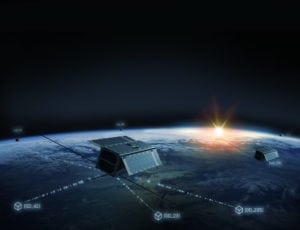Latest News
[Via Satellite 12-15-2016] Swiss start-up ELSE has raised more than $4 million in funding, putting the company on track to launch two demonstration nanosatellites in the fourth quarter of 2017, the first in its 64-nanosatellite Machine-to-Machine (M2M) constellation, Astrocast. The company is still looking to raise the last $1 million in its seed funding round in order to take it to launch, as well as another $6 million in Series A funding in 2017. Still, ELSE has already seen hefty investment from the European Space Agency (ESA), the Swiss government, and private investors, as it looks to introduce the constellation dedicated to the Internet of Things (IoT) and M2M that the company says it can design, build, launch and operate for under $50 million.
“Most of our customers will be systems integrators who will purchase our low-cost, miniaturized NanoLink terminal that can be integrated into any type of outdoor equipment, whether it’s fixed or mobile. We have customers from the automotive segment, maritime, heavy machinery, fleet monitoring, [and] transportation of hazardous material. We have received interest from drone companies, water metering systems, animal-tracking — every week we discover new potential applications for Astrocast and this new demands exist only because we are offering something low cost,” said Fabien Jordan, co-founder and CEO of ELSE, in an interview with Via Satellite.
The company has booked several letters of intent as well as an unnamed anchor customer, a company that services water meters in the Middle East, which has pre-ordered ELSE’s NanoLink terminals and also invested some capital into getting Astrocast off the ground.
Once operational in 2018, the constellation will provide remote monitoring, geolocation services, predictive maintenance and intelligent data gathering by enabling M2M services. This is done through the integration of the NanoLink terminal on a company’s assets, which can send any kind of sensor data to the constellation of nanosatellites that will acknowledge the reception. Astrocast will enable transmission of 1 KB per day from any region on Earth, according to ELSE’s website.
Much of the company’s competitive pricing is spurred by the design and manufacture costs of each satellite ELSE is manufacturing in house, which sits under $500,000 per nanosatellite, according to Jordan.
“We know it will be less than half a million to manufacture one. Costs will decline with economies of scale, so if we manufacture 20 of them, we believe we can go down to $300,000 or maybe $250,000,” he told Via Satellite.
The constellation is set to enter commercial service in late 2018 when ELSE will place the first eight satellites into orbit. ELSE will launch the satellites in groupings of eight, with the second launch planned for 2019, and aims to drive the launch cadence up to two launches a year in 2020 and 2021. With the plan to have all 64 nanosats in orbit by 2021, the company is hoping to service the mobility market. In the meantime, however, it will focus on introducing M2M to the Fixed Satellite Services (FSS) market.
“We will address both the fixed satellite services and mobile satellite services, but our long-term objective is really to target the mobility market. We know that there is a growing need for global connectivity for geolocation and remote monitoring,” said Jordan, citing this as the reason the company will target mobility satellite services in the long run.
After launching its first group of satellites at the end of 2018 into a single orbital plane, the service’s latency time will still be quite high, which will limit the company to servicing the FSS market in which low latency isn’t critical.
“Every year after that, when we launch new orbital planes to reduce this latency time, the mobility sector becomes the main market,” said Jordan.
With a design lifetime of three to five years, the company is planning to replace its spacecraft in orbit every three years, but Jordan says ELSE has also proven with a previous mission that a nanosatellite can be upgraded to operate more than seven years on orbit.
“We certainly hope that we can make them last more than three years,” he said.
The company has not yet chosen a launch provider for its constellation but says it is looking to new entrants in the micro-launcher market, such as RocketLabs or Vector Space Systems, to help diversify access to launch and help launch drive costs down.
“There is a lot of constellations being built and you need a lot of launch vehicles to do it and there’s only so many SpaceX flights per year, or [Polar Satellite Launch Vehicle] PSLV flights per year, or Antares flights per year, so you need others as well and that’s where we believe new launchers could help to launch our constellation,” Kjell Karlsen, CFO of ELSE told Via Satellite.
With its demonstration launch set for the end of 2017, Jordan says the company will have plenty of work set out for it in the new year.
“2017 is a very important year for us,” said Jordan. “We have to finalize the development of not only the space segment but the ground segment and the M2M protocol, and we will begin testing. We want to get the first satellites off the ground by the end of next year, maybe in the beginning of 2018, and this year it is very important to complete our funding rounds.”
Get the latest Via Satellite news!
Subscribe Now